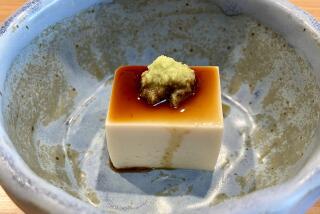DIVERSIONS : Steamy Truth About Japanese Baths : * Relaxation: A trip to the <i> sento </i> transcends the uninspired approach to bathing taken by many stressed-out Americans.
- Share via
In this era of Japan bashing, it’s easy to forget that a couple years ago almost all things Japanese--design, technical innovation, fashion, sushi, workaholism--were practically worshiped in this country.
But there was one aspect of Japanese life that never found much acceptance in the West--the Japanese bath.
That’s a pity. Indeed, there are other activities that are as relaxing, sensual or cleansing. But to experience all three simultaneously is the magic of a traditional bath as it is done in the sento, the bathhouse in Japan.
There are several public baths in the Los Angeles area where you can get a hot soak, perhaps the best part of the Japanese bath experience. But there is only one public bath in Los Angeles where the full Japanese routine can be had--and it’s for men only.
“It is very hard to find a completely traditional bath in this country,” says Robert Hori, director of the Doizaki gallery at the Japan American Community Culture Center and a devotee of Japanese customs. “And it is getting harder to find in Japan, especially in the major cities.”
The bathhouses served a practical purpose in Japan, a country where cleanliness is an integral part of the culture rooted in the centuries-old Shinto religion. Purification ceremonies play an important role in Shinto practice and every object used in religious ceremonies must be scrupulously clean.
The demise in public baths in Japan--there were once more than 1,000 in Tokyo--is due to the fact that most homes now have their own bathing facilities including, in some cases, showers. But the public bath lives on as a place to meet friends, gossip and soak together.
The most traditional bath in Los Angeles is Tawa’s Shiatsu Spa, an unassuming storefront in Little Tokyo.
Inside the door is a rack for your shoes and a counter where you pay.
A public bath in Japan is inexpensive, about 250 yen (less than $2). That, unfortunately, is not the case at Tawa’s, where the basic visit costs $15, with the bath price considerably reduced with massage. (Although women are not permitted in the bath area, they can get a massage.)
Your first stop after the counter is the dressing room. Here you get a towel, but you must first bathe before taking a bath.
The idea is to get completely clean before you soak in the public tub. It makes the process longer, but it does make more sense than sitting in a tub of your own grime as is done in the West. (If someone breaks the rules by getting into the tub dirty or covered with soap suds, the bath will be closed, drained and scrubbed before it is reopened to the public.)
In one corner by the tub is a stack of little plastic benches and buckets. Take one of each and proceed to the faucets low to the floor along one wall. You squat way down to sit on your bench (it can be a bit cramped for the tall, who have to push a way back from the wall) and fill your bucket with warm water.
Douse yourself several times and then lather up with the soap and shampoo that is provided, or you can bring your own.
At this point, you can also shave, using the mirror above the faucet. Personally, my shaves at home have overtones of self-sacrifice--I almost always manage to nick myself. But shaves at Tawa’s are smoother and cut-free. Perhaps the steamy atmosphere softens the skin.
In the West, this part of the experience is generally done solo, although in Japan etiquette calls for younger bathers to offer to wash the backs of their elders.
You rinse yourself by repeatedly filling the bucket and pouring warm water over your body.
Now you’re ready for the tub.
The clean water at baths in Japan is generally heated to at least 110 degrees Fahrenheit, although I suspect it’s a shade cooler at Tawa’s.
The trick to getting into a tub of very hot water is to step right in and then remain as motionless as possible while your lower body adjusts to the heat.
This happens surprisingly quickly. But the heat is jarring and those with heart or other health problems are well advised to check with a doctor first.
After you adapt, you sit the rest of the way down on the ledges at the edge of the tub, letting the water come all the way up to your neck. Generally, the Japanese don’t dunk their heads.
Then comes a nice long soak. It’s not impolite to strike up conversations with others sharing the tub, although loud behavior is certainly frowned upon.
When you emerge, your skin and soul feel wonderfully refreshed.
This is the end of the traditional bath, although in the West (and increasingly in Japan) you have several options from here for no additional charge, including a steam bath or sauna. Or you can sit on Leatherette sofas in the lounge and watch TV with other patrons, almost all of whom will be Japanese and many of whom will smoke.
You can return to the hot tub several times, although it’s a good idea to rinse off a bit at the faucets if you get sweaty.
When I’m all done and back in my street clothes, I like to cool down by taking a stroll through Little Tokyo. You could, of course, simply get in your car to go home or back to work, but I find the longer I stay out of traffic, the longer the effects of the bath last.
Tawa’s Shiatsu Spa, 362 E. First St., Los Angeles. Info: (213) 680-9141.



